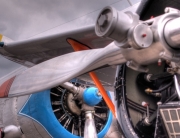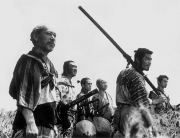So here we start digging in the heart of the subject. I think every pilot can agree that the biggest part of CRM residesin the cockpit, where he/she will have to spend the rest of his career either dealing with good/bad pilots or just complete idiots! But it goes beyond just learning to ”deal with” somebody.
(If you haven’t read the introduction to this first part, you can use this link to read it)
In the cockpit, not only does a pilot have to constantly learn and perfect his technique and skills related to flying an airplane, he/she also usually have to learn how to deal with a peer. Some are lucky (or unlucky) and get to know and fly with only one partner for a while. When flying with Max, we started to half-jokingly fight about the overhead pannel switches. We figured that by the end, there would be yellow crime-scene tape surrounding the fuel boost pumps switches, because I was always touching them even when I was pilot flying and it was the pilot not-flying job’s to deal with them. Despite having less flying experience than any other pilot I flew with, my dear friend Max has tought me a lot more about managing a two-crew cockpit, simply by being persistant and insisting on adhering to Standard Operating Procedures, or SOPs. It took him a few months, but by the end he had full control of the fuel pump switches when he was PNF. 🙂 He really pushed me out of my single pilot habits and forced me to realize that it doesn’t matter what size the cockpit is – SOPs are there for a reason, and deviating from them for any reason can cause confusion and frustration to everybody involved.
However, the bigger the company, the more the crews rotate and one ends flying witha different partner often. Sadly, a twisted misconseption has started spreading among the professional pilot industry. Despite strict and well elaborated SOPs, it is still the belief of many that a basic First Officer skill is to learn to be a chameleon. Even in ground school CRM classes, teachers have been heard saying jokingly that really all a copilot needs to know is what the captains take in their coffee. Although amusing, this represents a reality present in the mindset of many mid-size operations, where although SOPs are part of the day-to-day operation, they are still used more or less as a ”guideline”, allowing the captains to each fly the airplane and run the procedures as they prefer, and not as underlined in the SOPs, leaving the First Officers with the task of memorizing every captain’s different way of doing something, different preferences, and catching up with surprises when one decides to do things a different way.
This practice is frowned upon in major operations but still plagues our small and midsize operators, where the repercutions are a lot weaker for the captains. But are we really going to wait for an accident to happen before deciding that enough is enough? Already I have seen for myself multiple instances where deviation from SOPs has opened the door to a dangerous situation that could have been avoided otherwise. A change of attitude in this matter could also provide a much more relaxed and open environment in the cockpit, where FOs would not be afraid of being scorned for doing something that ought to be done, or that he thinks is what the captain is expecting, etc etc…
At the same time, I must urge First Officers (especially the shyer ones like me) to learn to share their opinions and thoughts on the decisions made and whatever they have on their mind. Accidents have already shown that the silence or “reverence” the first officer will show to an assertive captain can lead to fatalities or problems that could have been avoided. Never hesitate to call an overshoot, double-check a number or question a decision if you feel like your safety and that of the airplane is in jeopardy. It is your right as well as your duty.
One thing to also be careful of is doing things ”just for shizzle” or ”just ‘cuz”. Making a habit of doing little things ”just cuz” can unknowingly lead to complacency. So do yourself a favor, and either do it for a reason or don’t do it at all!
Now, you say, what if I’m just flying around for fun with my buddy in his Piper Warrior? No SOPs to dictate what to do… Well, I say, just use common sense! Planning, Briefing and otherwise Communicating are the key elements to cooperation and openness in a cockpit. It allows to avoid surprises, which is never a good word in aviation!
Finally, peer pressure !! Oh how much could be said about that one. I’ll be pretty straightforward with you on this matter. I have seen way too many good pilots do something stupid because of those two little words. I still feel bad for every little incident that happened because I pressured (willingly or not) the other guy into doing something silly/stupid, and I feel even worse for letting myself being pressured into doing similar things. Usually if somedody acts because of peer pressure, they didn’t feel comfortable about what they’re about to do in the first place. And that goes directly against good judgement and safety management. So whether you are a 747 captain or a private pilot, always think twice before trying to convince somebody to do something ”just for fun”, and think even harder before letting yourself being talked into doing something that you are not comfortable with. A few examples of common traps are: accepting to land with more tailwind than what you’re comfortable with to ”save time”, trying to prove that you can do maneuver ”abc”, etc etc…
So to conclude this first part, here are a few key points
1) Plan, Brief, and otherwise Communicate your intentions to everybody involved. It reduces frustration and confusion 🙂
2) Stick to SOPs. Home made profiles and procedures are an easy receipe for trouble
3) Beware of peer pressure!
4) Put away all misconceptions, preconceptions, and suppositions. Learn to deal with facts and procedures.
********************************************
Here are the other parts of this Article
Chuck Yeager and You – Or the Human Factor (Intro)
Chuck Yeager and You – Or the Human Factor (Part 2 – CRM Outside the Cockpit)



I always jokingly refer to them as “Suggested Operating Procedures”. Applies at almost all 703/704 operators…